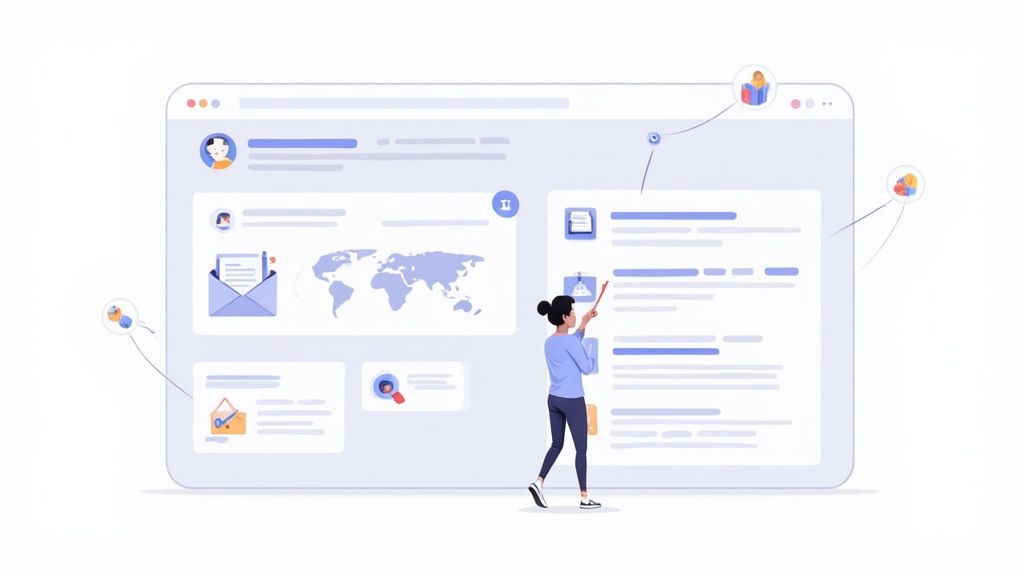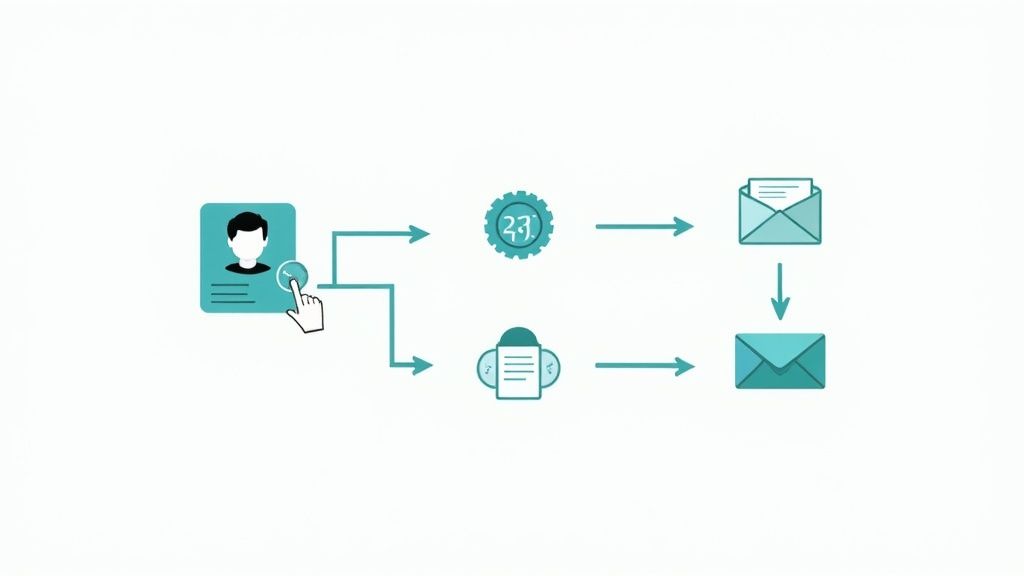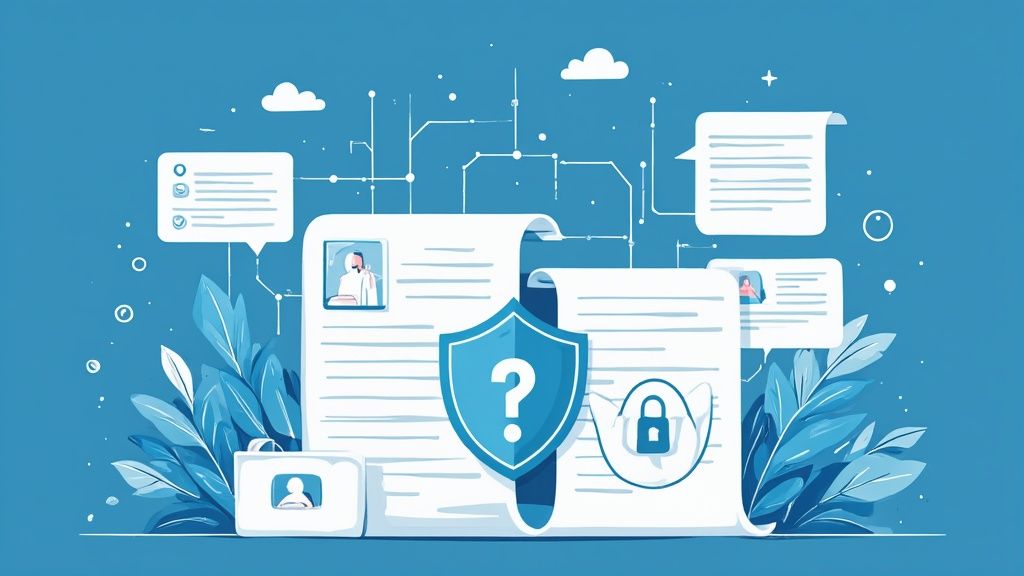Let's be honest, procurement can feel like drowning in paperwork. A procurement document request system is your team's lifeline. It’s a dedicated digital tool designed to automate and centralize the entire headache of asking for, keeping track of, and managing all the documents that come with buying things.
Think of it as the ultimate digital organizer for your procurement team, making sure every RFP, contract, and compliance form is exactly where it needs to be, easy to find, and ready for an audit at a moment's notice.
What Is a Procurement Document Request System Anyway?

Picture this all-too-common scenario: your team’s most important documents—vendor contracts, insurance certificates, purchase orders—are scattered across desktops, buried in email chains, and saved in random network folders. Finding the right version of a single document feels like a frantic, time-wasting scavenger hunt.
A procurement document request system steps in to bring order to that chaos.
This isn't just another shared folder. It’s an active, intelligent hub that completely changes how you handle documentation. The system automates requests sent to suppliers, pushes them through the right internal channels for approval, and gives you a real-time view of where everything stands. It transforms a clunky, manual process into a smart, predictable workflow.
So, What's Its Real Job?
At its core, this system tackles a massive business headache: managing the endless paper trail that comes with sourcing and purchasing. It creates a single source of truth that keeps your team, your suppliers, and any other stakeholders on the same page, ensuring everyone is working from the most up-to-date information.
The need for this kind of organized approach is growing fast. The global document management systems (DMS) market, which is the foundation for these platforms, is expected to jump from USD 10.51 billion in 2025 to USD 19.81 billion by 2030. This growth shows just how much pressure businesses are under to keep their records secure and auditable.
A procurement document request system isn't about simple storage. It's about building an interactive, efficient, and fully auditable ecosystem for every single document that flows through your procurement department.
The Old Way vs. The New Way
To really see the difference, let’s compare how things get done. The table below shows the stark contrast between relying on old-school manual methods and adopting a modern, automated system.
| Feature | Manual Process (Email & Spreadsheets) | Procurement Document Request System |
|---|---|---|
| Requesting Documents | Manual emails, constant follow-ups, easy to miss. | Automated, scheduled requests and reminders. |
| Tracking Status | Relies on a messy spreadsheet or memory. Who has it? | Centralized dashboard with real-time status updates. |
| Document Storage | Scattered across inboxes, desktops, and shared drives. | A single, secure, and searchable repository. |
| Version Control | Nightmare. "Final_v2_final_FINAL.docx" is common. | Automatically manages versions, ensuring one source of truth. |
| Audit Trail | Difficult to piece together. Who did what and when? | Complete, time-stamped audit trail for every action. |
| Supplier Experience | Confusing and frustrating with multiple points of contact. | Simple, clear portal for suppliers to upload documents. |
Without a dedicated system, a simple request for a supplier’s insurance certificate can unleash a flurry of emails, follow-ups, and version control chaos. With a system, that same request becomes an automated, trackable task that runs itself. This shift isn’t just about convenience; it’s about cutting down on risk, building better relationships with suppliers, and making your entire procurement operation more strategic.
At the end of the day, a procurement document request system is a highly specialized document management tool. For a look at how these principles apply in another document-heavy industry, check out this ultimate guide to real estate document management systems. The core goals of efficiency and compliance are universal.
How This System Delivers Real Business Value

So, what does a procurement document request system actually do for a business? It's easy to talk about benefits, but let's get real. Think about the daily grind: chasing suppliers for paperwork, dreading the next audit, and fielding constant questions from internal teams who can't find what they need. A good system tackles these frustrations head-on.
The real magic happens when you shift from reactive, chaotic processes to proactive, controlled ones. Instead of your team being buried in spreadsheets and follow-up emails, the system does the heavy lifting. This frees everyone up to focus on what really matters—strategic thinking and building value.
At its heart, this kind of system is all about smart automation. So much time gets eaten up by repetitive administrative chores. For a deeper dive into this concept, understanding task automation for small enterprises can show just how big of an impact it can have across the board.
Boost Compliance and Simplify Audits
Compliance is one of procurement's biggest headaches. A single missing certificate of insurance or an expired quality document can open your company up to serious risk. This is where a dedicated system earns its keep by acting as a vigilant compliance watchdog.
It automatically creates an ironclad audit trail, logging who requested what, when it was submitted, and who signed off on it—all with a timestamp. When the auditors show up, there’s no more panicked scrambling. You can pull a complete, organized report in just a few minutes.
A procurement document request system transforms audits from a dreaded, disruptive event into a routine, stress-free checkpoint. It provides undeniable proof of due diligence.
Accelerate Procurement Cycle Times
Let's be honest: time is money, and manual document collection is a notorious time-waster. That endless cycle of sending emails, making phone calls, and checking things off a list grinds the entire procurement process to a halt. It slows down everything from onboarding a new supplier to closing out a critical project.
A procurement document request system puts this entire sequence on autopilot.
- Automated Reminders: The system gently nudges suppliers about approaching deadlines or expiring documents. No more manual follow-ups from your team.
- Centralized Portal: Suppliers get one simple, clear place to upload everything. This cuts down on the confusion and the constant back-and-forth.
- Instant Visibility: Your team gets a bird's-eye view of every request on a central dashboard, which eliminates guesswork and makes planning much easier.
This level of automation drastically shortens the time it takes to gather information, speeding up project timelines and making your whole operation more agile.
Build Stronger Supplier Relationships
Nothing sours a supplier relationship faster than a messy, disorganized process. When you bombard them with confusing emails from different people or ask them to resubmit paperwork they’ve already sent, it tells them you don't value their time.
A well-designed system offers a professional and consistent experience. By giving suppliers a straightforward way to provide what you need, you're showing them respect and making their lives easier. This simple shift does wonders for communication, builds trust, and helps create stronger, more collaborative partnerships for the long haul.
If you’re ready to make this change, exploring specialized document collection software is a great place to start.
The Must-Have Features of Your System

When you start looking at procurement document request systems, you’ll quickly find they aren't all built the same. It's a bit like buying a car; some features are standard and absolutely necessary, while others are just fancy extras. To get a system that truly works for you, you have to nail the fundamentals first.
These core features are what separate a simple digital filing cabinet from a powerhouse platform that can drive your entire procurement process. Let's dig into the non-negotiables.
Centralized Document Library with Version Control
Think of this as your digital command center. A centralized library puts every single contract, RFP, quote, and compliance form into one secure, easy-to-find place. Gone are the days of digging through old emails and shared folders just to find the right file.
But a library alone isn't enough—it absolutely must have version control. This is a lifesaver. It automatically tracks every change made to a document, so you always know you're looking at the latest draft. It's the ultimate cure for the chaos of files named "Contract_Final_v2_FINAL.docx" and gives everyone a single source of truth.
Automated Workflows and Reminders
Let's be honest, manually chasing people for approvals or updates is a huge time sink. A great procurement system takes this off your plate with workflow automation.
A system with strong workflow capabilities doesn't just store documents; it actively moves them through the necessary steps for review, approval, and renewal, creating a truly hands-off process.
You can set up custom approval chains, so a request automatically moves from one person to the next without you having to do a thing. It also sends out automatic reminders for expiring contracts or supplier paperwork, which is a core part of any good document workflow automation. This keeps everything moving forward without constant nagging from your team.
Powerful Search and Reporting
What's the point of storing everything if you can't find it when you need it? A system is only as good as its search function. You should be able to instantly pull up any document using a keyword, supplier name, date range, or custom metadata.
Good reporting is just as crucial. It gives you that 30,000-foot view of your entire procurement operation. You can track vital metrics like supplier compliance levels, how long it takes to approve a document, or what requests are still pending. This data is gold for spotting bottlenecks and making smarter decisions.
Seamless Integrations and Security
Your procurement system can't be an island. To be truly effective, it needs to connect and communicate with the other tools you rely on every day.
Look for key integrations with:
- Accounting Software: To sync up invoices and purchase orders.
- ERP Systems: To create a unified view of business operations.
- E-Signature Platforms: To make the final contract signing process smooth and quick.
Finally, you can’t compromise on security. Make sure any system you consider has top-notch features like data encryption, role-based access so people only see what they need to, and a full audit trail. Protecting your sensitive data isn't just a good idea—it's essential for compliance.
A Practical Guide to Implementing Your New System

Rolling out a new procurement document request system can feel like a huge project, but when you break it down with a solid roadmap, it becomes much more manageable. Honestly, a successful launch isn't about having a team of tech geniuses. It's about smart planning that centers on what your people actually need.
A structured approach is the best way to guarantee a smooth transition and start seeing benefits right away.
The first, most critical step? A proper needs assessment. Forget about assumptions. You need to get out there and talk to the people who will be using the system every single day.
Sit down with your procurement specialists, finance team, and even your most important suppliers. Ask them what their biggest headaches are with the current process. What wastes the most time? Where do things fall through the cracks? What compliance issues are keeping them awake at night?
This direct feedback is pure gold. It gives you the ammunition you need to build a compelling business case and get everyone on board with the change.
Choosing the Right Partner and Planning Your Rollout
Once you have a firm grasp of your requirements, finding the right vendor becomes a whole lot easier. You’re no longer just ticking boxes on a feature list; you're looking for a partner whose system genuinely solves the problems you've uncovered. Make a checklist of your absolute "must-have" features and use it to score potential vendors.
After you've picked your system, fight the temptation to go live for the entire company all at once. Trust me, a phased rollout is almost always the smarter move.
- Start with a Pilot Group: Find a small, enthusiastic team to be your guinea pigs. Their experience will be invaluable for catching and fixing any issues before the company-wide launch.
- Configure and Migrate Data: Work side-by-side with your pilot group to set up the system's workflows to mirror how your team actually works—not the other way around. Plan your data migration deliberately, starting with the most active and important documents to ensure a clean start.
- Train for Adoption, Not Just for Use: Training needs to be more than a one-time webinar that everyone forgets. Your goal should be to create internal champions who can provide ongoing support to their colleagues. When you show people exactly how the new tool makes their specific job easier, you'll get genuine adoption, not just reluctant compliance.
A well-planned implementation isn't just an IT project; it's a strategic business initiative. By focusing on user needs and a phased rollout, you ensure the system is adopted enthusiastically, not reluctantly.
This kind of strategic thinking is a major reason why the Procurement as a Service (PaaS) market is expected to hit USD 17.17 billion by 2032. Just look at companies like General Electric. They managed to slash procurement costs by up to 25% by moving to cloud-based tools, proving that a thoughtful digital switch leads to real savings and a stronger bottom line. You can explore more about these procurement market trends to see how these systems are giving companies a serious competitive advantage.
Seeing the System in Action: Real-World Examples
It's one thing to talk about benefits in theory, but the real magic of a procurement document request system happens when you see how it solves specific, expensive problems for actual businesses. These systems aren't cookie-cutter solutions; they're flexible tools that adapt to the unique headaches of different industries.
Let's walk through a few scenarios to see how this works on the ground, from the factory floor to the hospital wing.
Use Case 1: The Manufacturing Firm
Picture a large manufacturing company that relies on dozens of global suppliers for its raw materials. Every single shipment requires a stack of compliance paperwork: certificates of analysis, origin declarations, quality control reports—the list goes on.
Their old process was a nightmare of scattered emails and disjointed spreadsheets. This chaos often led to serious production delays whenever a crucial document went missing. After bringing in a procurement document request system, they built a single, unified supplier portal.
- The Problem: Keeping track of thousands of time-sensitive compliance documents, each tied to a specific batch of materials.
- The Fix: The new system automatically sends document requests to suppliers the moment a shipment is created. A central dashboard instantly flags anything that's missing or expired.
- The Payoff: They saw a 95% drop in production holds caused by compliance issues. Plus, they now have a perfect, auditable document trail, which significantly cuts down their risk.
Use Case 2: The Healthcare Provider
Now, think about a hospital juggling hundreds of vendor contracts. These aren't just simple agreements. They include ironclad HIPAA business associate agreements and vital service-level agreements (SLAs) for life-saving medical equipment. The regulatory pressure is intense.
In healthcare, a single mismanaged vendor contract can trigger massive compliance fines and directly impact patient care. The system is less of a convenience and more of a critical risk management tool.
The hospital configured its system to put the entire contract lifecycle on autopilot. It automatically sends renewal reminders 90 days before a contract is set to expire and securely archives old versions. This simple automation ensures a critical contract never accidentally lapses, protecting the hospital from devastating compliance breaches and service disruptions.
Use Case 3: The Fast-Growing Tech Company
Finally, let's look at a tech startup that's scaling at lightning speed. They're onboarding new software vendors every week, each one needing signed license agreements, data processing agreements (DPAs), and detailed security questionnaires. Their small procurement team was completely swamped.
They used a document request system to create simple, standardized templates for different types of vendors. If you're facing a similar issue, it's worth learning how to collect documents from third parties more efficiently to manage this kind of workload.
This one change allowed their team to handle 5x the volume of vendor onboarding without hiring more people. New employees could get the software they needed to do their jobs in hours, not weeks.
Choosing the Right System for Your Business
Picking a procurement document request system isn't about finding some magical, one-size-fits-all platform. Honestly, the "best" system is simply the one that fits your company's reality—your team size, your budget, and the tools you already use. It's easy to get wowed by a long list of features, but the right choice comes from asking a few practical questions first.
Think about where your business is headed. Will this system grow with you? A tool that’s perfect for a five-person team might completely fall apart when you scale to fifty. Scalability is a huge deal because ripping out a system and starting over a few years down the road is a nightmare you want to avoid. You also have to think about your team. A system loaded with powerful but complicated features is worthless if no one can figure out how to use it. The easier it is to use, the more likely your team will actually embrace it.
Key Questions to Ask Vendors
Before you even think about signing a contract, you need to get some straight answers from potential vendors.
-
Integration: How well will this play with our current accounting software or ERP? If it doesn't connect smoothly, you’re just creating more manual work and isolated data, which defeats the whole purpose of getting a new system.
-
Total Cost: What’s the real price? The subscription fee is just the beginning. Ask about any and all hidden costs for implementation, training, data storage overages, and what their support packages actually include. This gives you the true total cost of ownership, not just the sticker price.
Choosing a system is a strategic decision, not just a software purchase. The right platform should feel like a natural extension of your team, making their work easier, not adding another layer of complexity.
Comparing Your Options
So, what are your main choices? Most businesses find themselves deciding between a dedicated, specialized platform or a module that’s part of their bigger Enterprise Resource Planning (ERP) software. Each path has its own set of pros and cons depending on what you value most.
To help you see the difference, let's break them down.
System Type Comparison for Your Business
| System Type | Best For | Key Advantages | Potential Drawbacks |
|---|---|---|---|
| Standalone System | Teams needing specialized features and a user-friendly interface. | Highly focused on document collection, often more intuitive and quicker to deploy. | May require building integrations with other business software. |
| ERP Module | Large organizations seeking a single, all-in-one business solution. | Natively integrated with finance and operations data for a unified view. | Can be less user-friendly, more expensive, and slower to customize. |
Ultimately, a standalone system gives you best-in-class features for a specific job, while an ERP module offers convenience and built-in connections to your other business data. The right choice depends entirely on your priorities.
Have a Few Questions? We Have Answers.
It's natural to have questions when you're looking at bringing a new system into your workflow. Let's tackle some of the most common ones that come up when teams consider a procurement document request system.
How Long Does It Take to Get Started?
This is probably the most common question we hear, and the answer is often "faster than you think." For a simple, out-of-the-box setup with a cloud-based tool, you could be up and running in a matter of days.
If you're looking at a more involved rollout for a larger organization—think custom workflows, integrating with other software, and moving old data over—you’re typically looking at a timeline of two to six weeks. A smart approach is to begin with a small pilot team to smooth out the process before you go live for everyone.
What Kinds of Documents Can This System Actually Handle?
A good system is built to handle just about anything you throw at it. It's not just a digital filing cabinet for PDFs. It’s designed to manage the wide variety of documents that keep a business running.
This includes things like:
- Contracts and Agreements: All those critical legal documents that need careful review and signatures.
- Compliance Paperwork: Think certificates of insurance, quality control reports, and all the necessary regulatory forms.
- Supplier Details: Essential info like W-9s, banking information, and company policies.
The real power comes from using templates and custom fields. This ensures you’re not just storing a document, but you're also collecting all the right information that goes with it, every single time.
Think of it this way: these systems don't just hold your documents; they understand them. They adapt to what you need, making sure every piece of information is managed correctly and kept secure.
Ready to stop chasing paperwork and start building a smarter workflow? Superdocu makes it easy to collect, track, and manage all your essential documents in one secure place. Start your free trial today and see how simple it can be.
